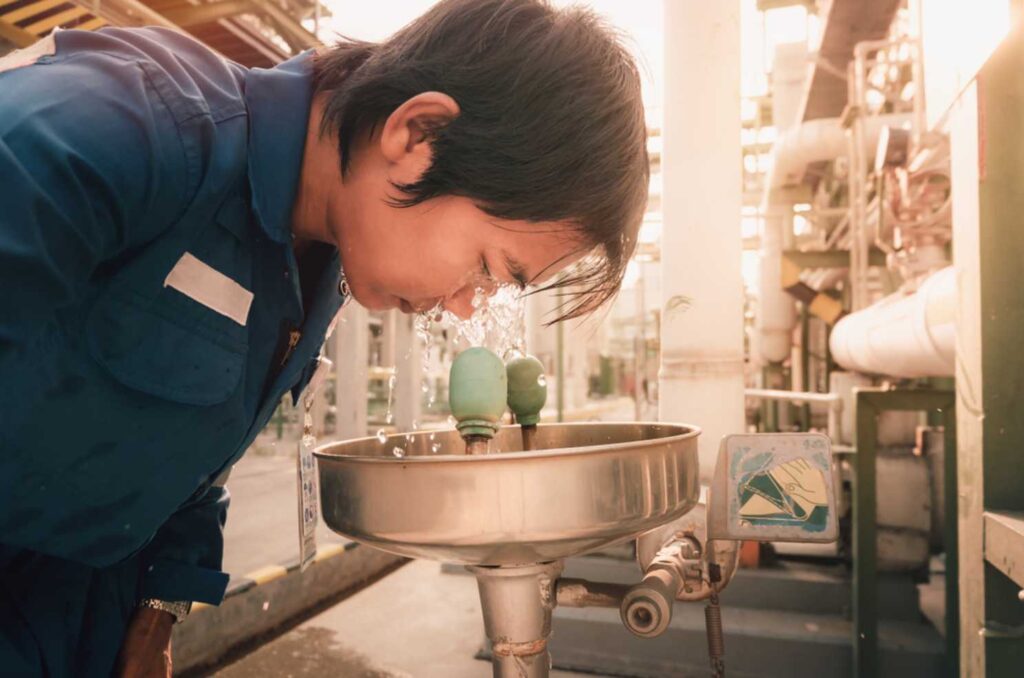Safety 101: Testing Emergency Eyewash Stations for Functionality

The presence of hazardous materials and liquid chemicals in your workplace can be quite a challenge because you want to make sure your resources,
employees and your workplace safety should be your topmost priority.
Unlike other workplaces where accidents may not always be a big thing — any accident that may occur in the presence or due to hazardous chemicals needs to be treated and addressed immediately. With this, having emergency management procedures such as emergency eyewash stations can make all the difference.
However, having an eyewash station is not the end all by all. As a company, it is your duty to make sure that these eyewash stations remain functional at all times.
With this, we’ve created a guide on how to test your emergency eyewash station before an emergency occurs!
Understanding the Importance of Eyewash Stations
Emergency eyewash stations are made to quickly help people who have harmful substances in their eyes.
These stations provide a continuous flow of water or a saline solution to wash away any contaminants. The effectiveness of these stations can greatly affect how serious the injuries are after an incident. Therefore, regular testing is important to make sure they work properly when needed.
Read: How to use an Emergency Eyewash Station
Establishing a Testing Schedule
To ensure your emergency eyewash stations are functional, it is essential to establish a regular testing schedule. This schedule allows for early detection of any issues and ensures that the equipment remains in good working order.
Your testing schedule should include a checklist to document each test’s results. This practice not only helps maintain accountability but also provides a record that can be useful during safety audits. Keeping a detailed log can also help identify any recurring issues, allowing for prompt corrective actions.
Conducting Functionality Tests
Testing the functionality of your emergency eyewash stations involves several steps. Here’s how to carry out effective tests:
- Visual Inspection
Begin with a visual inspection of the eyewash station. Ensure that the area around the station is clear of obstructions, making it easily accessible in an emergency. Check for any signs of damage or corrosion, and ensure that all components are intact.
- Flow Rate Test
Next, perform a flow rate test to ensure that the eyewash station delivers an adequate volume of water.
To conduct this test, turn on the station and let it run for a minute. Use a flow metre or container to measure the amount of water dispensed during this time. If the flow rate is below the standard, immediate repairs or replacement of the unit is necessary.
- Temperature Check
Water temperature is crucial for an effective eyewash station. Ideally, the water should be tepid, which is defined as being between 60°F (15.6°C) and 100°F (37.8°C). Extreme temperatures can cause further injury to the eyes.
Use a thermometer to check the water temperature. If the water is too hot or too cold, consider adjusting the system or adding a temperature control device to ensure compliance with safety standards.
- Flushing Test
After confirming the flow rate and temperature, it is time to flush the station. Run the eyewash station for at least three minutes to clear any stagnant water that may have accumulated. This practice helps prevent contamination and ensures that fresh water is available in case of an emergency.
Maintenance Best Practices
Routine maintenance is key to ensuring the long-term functionality of emergency eyewash stations. Here are some best practices to keep in mind:
- Regular Cleaning
Regular cleaning of all your emergency eyewash station equipment is essential for preventing contamination. Clean the basin and nozzles with a mild detergent and water solution to remove any buildup. Ensure that all components are rinsed thoroughly and dried before the station is put back into service.
- Check Replacement Parts
Make sure you have an emergency eyewash station checklist to monitor each part of your station.
Inspect all parts of the eyewash station regularly for wear and tear. Replace any damaged components, such as hoses or spray nozzles, promptly to maintain optimal performance. Keep a stock of replacement parts on hand to ensure quick repairs when needed.
- Train Employees
Training employees on how to use the emergency eyewash station is equally important. Conduct regular training sessions to familiarise staff with the equipment, emphasising the importance of immediate action in the event of an eye injury. Ensure that employees know the location of the stations and how to activate them.
- Document Everything
As mentioned earlier, maintaining a detailed log of all tests and maintenance activities is crucial. Documenting these activities can help identify trends and areas for improvement. Additionally, having a comprehensive record can be invaluable during safety inspections or audits.
Ensure Workplace Safety with Emergency Eyewash Stations
In the case of an eye injury, every moment matters. Making sure your emergency eyewash stations are working correctly can greatly affect the results for those injured. Take action now to protect your workplace and encourage a culture of safety for all employees.
Ecospill’s emergency eyewash station can help make sure you have the precautions in place should an emergency arise. Depending on your workplace structure and location, you can find the right one that fits your workspace with ease.
Visit our website and see how our products can help keep your workplace safe through proper chemical and spill management.
